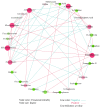Changes in Rhizosphere Soil Microorganisms and Metabolites during the Cultivation of Fritillaria cirrhosa
- PMID: 38785816
- PMCID: PMC11117757
- DOI: 10.3390/biology13050334
Changes in Rhizosphere Soil Microorganisms and Metabolites during the Cultivation of Fritillaria cirrhosa
Abstract
Fritillaria cirrhosa is an important cash crop, and its industrial development is being hampered by continuous cropping obstacles, but the composition and changes of rhizosphere soil microorganisms and metabolites in the cultivation process of Fritillaria cirrhosa have not been revealed. We used metagenomics sequencing to analyze the changes of the microbiome in rhizosphere soil during a three-year cultivation process, and combined it with LC-MS/MS to detect the changes of metabolites. Results indicate that during the cultivation of Fritillaria cirrhosa, the composition and structure of the rhizosphere soil microbial community changed significantly, especially regarding the relative abundance of some beneficial bacteria. The abundance of Bradyrhizobium decreased from 7.04% in the first year to about 5% in the second and third years; the relative abundance of Pseudomonas also decreased from 6.20% in the first year to 2.22% in the third year; and the relative abundance of Lysobacter decreased significantly from more than 4% in the first two years of cultivation to 1.01% in the third year of cultivation. However, the relative abundance of some harmful fungi has significantly increased, such as Botrytis, which increased significantly from less than 3% in the first two years to 7.93% in the third year, and Talaromyces fungi, which were almost non-existent in the first two years of cultivation, significantly increased to 3.43% in the third year of cultivation. The composition and structure of Fritillaria cirrhosa rhizosphere metabolites also changed significantly, the most important of which were carbohydrates represented by sucrose (48.00-9.36-10.07%) and some amino acid compounds related to continuous cropping obstacles. Co-occurrence analysis showed that there was a significant correlation between differential microorganisms and differential metabolites, but Procrustes analysis showed that the relationship between bacteria and metabolites was closer than that between fungi and metabolites. In general, in the process of Fritillaria cirrhosa cultivation, the beneficial bacteria in the rhizosphere decreased, the harmful bacteria increased, and the relative abundance of carbohydrate and amino acid compounds related to continuous cropping obstacles changed significantly. There is a significant correlation between microorganisms and metabolites, and the shaping of the Fritillaria cirrhosa rhizosphere's microecology by bacteria is more relevant.
Keywords: Fritillaria cirrhosa; metabolome; metagenome; rhizosphere.
Conflict of interest statement
The authors declare that this research was conducted in the absence of any commercial or financial relationships that could be construed as potential conflicts of interest.
Figures







Similar articles
-
Changes in enzyme activity and microbial community of rhizosphere soil under continuously monocultured Passiflora edulis treatment.PLoS One. 2025 Jul 16;20(7):e0328363. doi: 10.1371/journal.pone.0328363. eCollection 2025. PLoS One. 2025. PMID: 40668837 Free PMC article.
-
A rapid and systematic review of the clinical effectiveness and cost-effectiveness of paclitaxel, docetaxel, gemcitabine and vinorelbine in non-small-cell lung cancer.Health Technol Assess. 2001;5(32):1-195. doi: 10.3310/hta5320. Health Technol Assess. 2001. PMID: 12065068
-
Systemic pharmacological treatments for chronic plaque psoriasis: a network meta-analysis.Cochrane Database Syst Rev. 2021 Apr 19;4(4):CD011535. doi: 10.1002/14651858.CD011535.pub4. Cochrane Database Syst Rev. 2021. Update in: Cochrane Database Syst Rev. 2022 May 23;5:CD011535. doi: 10.1002/14651858.CD011535.pub5. PMID: 33871055 Free PMC article. Updated.
-
Sertindole for schizophrenia.Cochrane Database Syst Rev. 2005 Jul 20;2005(3):CD001715. doi: 10.1002/14651858.CD001715.pub2. Cochrane Database Syst Rev. 2005. PMID: 16034864 Free PMC article.
-
Responses of rhizosphere bacterial communities with different niche breadths to liquid fertilizer produced from Fuji apple wastes during planting process.Microbiol Spectr. 2025 Jul;13(7):e0206824. doi: 10.1128/spectrum.02068-24. Epub 2025 May 30. Microbiol Spectr. 2025. PMID: 40445252 Free PMC article.
Cited by
-
Pseudomonas chlororaphis ZH2: Evaluation of the Biocontrol Potential of Continuous Cropping Obstacles on the Basis of Genome Analysis, Autotoxic Substance Degradation and In Vitro Antifungal Activity.Curr Microbiol. 2024 Nov 29;82(1):21. doi: 10.1007/s00284-024-03998-x. Curr Microbiol. 2024. PMID: 39611886
References
-
- Li X., Song J., Wei J., Hu Z., Xie C., Luo G. Natural Fostering in Fritillaria cirrhosa: Integrating Herbal Medicine Production with Biodiversity Conservation. Acta Pharm. Sin. B. 2012;2:77–82. doi: 10.1016/j.apsb.2011.12.006. - DOI
-
- Chen T., Zhong F., Yao C., Chen J., Xiang Y., Dong J., Yan Z., Ma Y. A Systematic Review on Traditional Uses, Sources, Phytochemistry, Pharmacology, Pharmacokinetics, and Toxicity of Fritillariae cirrhosae Bulbus. Evid. Based Complement. Alternat. Med. 2020;2020:e1536534. doi: 10.1155/2020/1536534. - DOI - PMC - PubMed
Grants and funding
LinkOut - more resources
Full Text Sources

